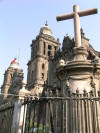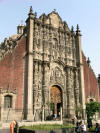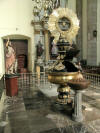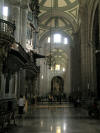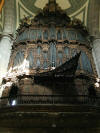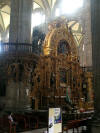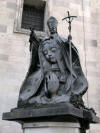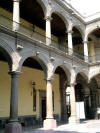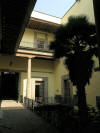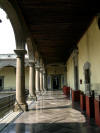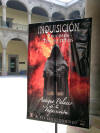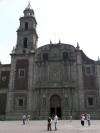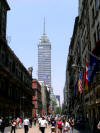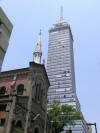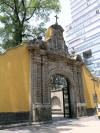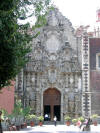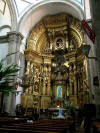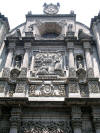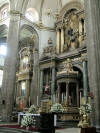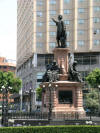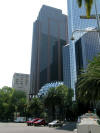Round The World and other travels
A frequent flyer's collection of trip diaries
This is: Canada & Mexico 2011
Centro Historico and Jaso Heaven
Today's programme, once again carefully compiled by Bruce, called for an in-depth exploration of the Centro Historico, visiting a wealth of interesting buildings both secular and sacred in the old city centre. And again, the idea was that an early start would allow us to keep ahead of the heat and the crowds. Of course, this was a normal working day for the locals and, reflecting this, the Executive Lounge was nothing like as quiet at breakfast time. We decided to try taking the subway to our starting point, rather than a taxi: it proved to be fairly user-friendly and not as crowded as expected. We soon emerged into the large main square, universally known as the Zócalo, but formally called the Plaza de la Constitución.
The problem, it turns out, is multi-faceted. In the first place, large parts of Mexico City are built on land once occupied by a lake, and many of the larger buildings started sinking practically from outset. Secondly, the sinking effect has been exacerbated in modern times, as the mushrooming population dries up the remaining underground water supply. And as if all that weren't bad enough, the city is surrounded by volcanoes and built directly on top of a geological fault line. This is not a destination for those of a nervous disposition!
What a stroke of bad luck! Trying not to be too disappointed, we continued our walk past the Museo del Templo Mayor, a major Aztec museum that we knew was closed on Mondays. We continued behind the cathedral and then northwards on Republica de Brasil until we reached the restored 18th century Palacio de la Escuela de Medicina. As well as being a medical school, it also once housed the Inquisition, which continued in Mexico right up to the War of Independence. As well as being interesting in its own right, the building contained a quirky medical museum and an exhibition, in Spanish, about the Inquisition. The contrast between the two exhibitions reflected the profoundly incongruous nature of the building's history: in this place dedicated to preserving life and improving the human condition through medicine, human beings once inflicted the most grotesque atrocities on each other in the name of maintaining supposed purity of faith. I found myself shaking my head to the point where I thought it might be in danger of working itself loose.
In due course, we set out along the Calle Cinco de Mayo in search of a further two historic churches. The first of these was the Iglesia de la Profesa, dedicated to St Philip Neri. As they were in the middle of midday Mass, we decided to come back to it. What would have been the final church of the day was Iglesia y ex-Convento de San Francisco, situated in the shadow of the Torre Latinoamericano skyscraper. We had to await the end of a service there as well, before it was appropriate to look around. Once part of the largest monastery in the city, now defunct, the surviving main church is noted for its fine altar and artwork.
We then retraced our steps to the Iglesia de la Profesa, dating from 1720 and reckoned to be one of the finest examples of Mexican Baroque architecture.
We had a perfectly acceptable lunch but, in line with what the guide books had led us to expect, it was nothing spectacular. At least one of the items on the menu didn't bear thinking about - see third picture above! Rested and re-fortified after the morning's exertions, we set off on the next leg of our exploration, which basically involved a lengthy walk all the way back to the Sheraton. We started out by passing the impressive sights of the Torre Latinoamericano, the Palacio Postal and the Palacio de Bellas Artes, but paid them scant attention at this time as they formed the basis of the plan for the following morning. Instead, we proceeded directly along the Avenida Benito Juárez, passing the edge of Alameda Central Park, until we met up with the Paseo de la Reforma, some 2km north-east of our hotel. Interestingly, we saw two different demonstrations in quick succession, one on Juárez and one on Reforma - the Mexicans certainly appeared to like their demos!
As we made our way towards the Sheraton, we soon came to the Monumento a Cristóbal Colón, or Christopher Columbus monument, dedicated in 1877. The next major intersection was marked by the Monumento a Cuauhtemoc, the last of the Aztec emperors. Continuing south-westwards, we soon came to the Bolsa Mexicana de Valores - the Stock Exchange, a landmark tower dramatically wedge-shaped, giving it an angled appearance. Trading takes place in a spherical dome covered in shimmering black and dark blue glass, while the offices are located in the tower itself.
After such a jam-packed programme of intensive sightseeing, you could be forgiven for thinking that our return to the Sheraton would effectively mark the end of the day. In fact you'd be terribly wrong, as a major highlight still lay ahead. After a rest, a chance to freshen up and cocktails in the Executive Lounge, we caught a cab to Polanco for a blowout dinner at the Jaso restaurant on Newton Street. At an attractive outdoor table on the upper-floor terrace, we were able to savour the nine-course chef's tasting menu, paired with wines. It was a fabulous feast:
 |
|
|
|
|
|
|
|
|
|
|
|
|
|
|
|
|
|
(Sorbet) |
|
|
|
|
|
|
|
A quick cab ride back to the Sheraton brought a busy and unforgettable day to a close.






